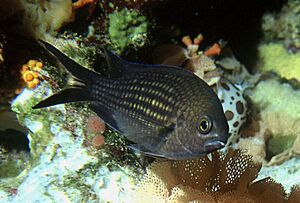Damselfish facts for kids
Quick facts for kids Damselfish |
|
|---|---|
 |
|
| Conservation status | |
| Scientific classification | |
| Synonyms | |
|
The damselfish, also known as the Mediterranean chromis, is a small fish found in the eastern Atlantic Ocean and the Mediterranean Sea. It belongs to the Pomacentridae family, which includes many colorful reef fish.
Contents
What Do They Look Like?
The damselfish has a body that is flat from side to side and shaped like an oval. It has a noticeably large eye. Its mouth can stick out quite a bit, reaching below the center of its eye. Inside its mouth, it has small, pointed teeth arranged in three rows.
This fish has two main fins on its back and belly:
- The dorsal fin (on its back) has 13-14 strong spines and 10-11 soft rays.
- The anal fin (on its belly) has 11 spines and 10-12 soft rays.
Its body, including its head, is covered in large scales. A special sensing line, called the lateral line, runs along its side and has 24-30 scales.
Color Changes
Young damselfish are a bright, shiny blue. As they get a bit older, they develop blue stripes, and their top and bottom fins are outlined in blue. Adult damselfish are dark brown. The center of each scale might be a lighter golden brown or gray-brown. The edge of their tail fin usually has no color, especially in the middle. When males are ready to mate, they turn a vibrant pale purple color!
Damselfish can grow up to about 25 centimeters (10 inches) long, but they are usually around 13 centimeters (5 inches).
Where Do They Live?
You can find the damselfish in the Black Sea, the Mediterranean Sea, and the eastern Atlantic Ocean. Their range stretches from Portugal down to Angola. They are also found around islands like the Macaronesian Islands and the Gulf of Guinea Islands. They seem to be more common near islands than near the mainland. They are not very common in the Black Sea or the Sea of Marmara.
These fish prefer coastal areas, especially rocky places. They live in waters from about 2 to 40 meters (6.5 to 130 feet) deep. You'll often see them swimming in small groups, called shoals, above or near rocky reefs and over seagrass beds.
What Do They Eat?
Damselfish mostly eat tiny creatures called zooplankton that float in the water. They also munch on benthic algae, which are small plants that grow on the seafloor.
Their diet includes:
- Tiny crustaceans called copepods.
- Small, free-swimming animals called appendicularia.
- Tiny water fleas known as cladocera.
- Larvae (baby forms) of snails and clams.
- Fish eggs and baby fish.
When larger fish or other activity happens near the surface, damselfish schools sometimes change their behavior. They might dive deeper to avoid trouble, even if it means leaving their food behind. This is a way for them to stay safe.
Fishing for Damselfish
Because they are small, damselfish are not a major target for large-scale commercial fishing. However, people often catch them for fun using light fishing gear during the day. They use small hooks baited with things like bread, pasta, small pieces of fish, mussels, worms, or tiny shrimp.
They can also be caught in fish traps and nets. Since they are so small, they are rarely caught with a speargun. Sometimes, damselfish are used as bait to catch bigger fish that like to eat them, such as the conger eel or the common dentex.
Cooking Damselfish
The meat of the damselfish is white, soft, and tender. Because of their small size, they are usually pan-fried whole. If you catch many small fish, they can be boiled together to make a tasty fish soup. Larger damselfish might be included in a mixed fish stew.
How They Reproduce
Damselfish usually lay their eggs during the summer, but the exact time can vary depending on where they live. A male and female damselfish will pair up and perform a special courtship dance. The female then lays her eggs in a nest that the male has prepared on rocky or sometimes sandy bottoms.
The eggs stick to the surface of the nest. The male damselfish then guards the eggs until they hatch, protecting them from predators. A female can lay a large number of eggs, anywhere from about 6,000 to over 73,000!
Gallery
-
A school of damselfish (with a saddled seabream in the background)





